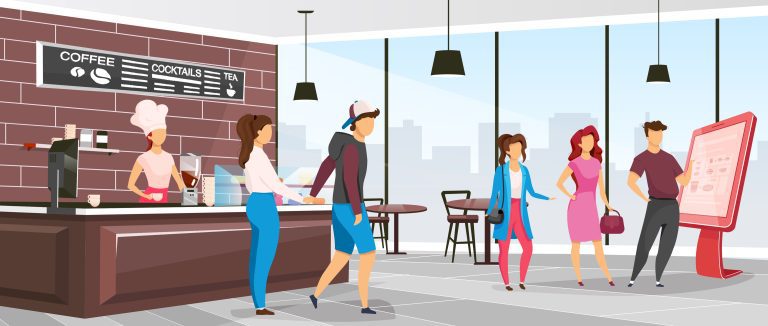Hospital retail dining is more than a cafeteria — it’s a lifeline for busy staff, a comfort for visitors, and a key revenue driver for healthcare systems. With rising food costs, labor shortages, and growing demand for convenience, operators are under pressure to deliver more with less.
That’s where AI tools like ChatGPT, paired with cafeteria POS systems, self-service kiosks, and digital ordering platforms, are helping hospital dining teams improve efficiency, reduce waste, and create a better experience.
1. Smarter Menu Planning for High-Traffic Hospital Retail Dining
Hospital cafeterias see waves of customers during shift changes and visiting hours. ChatGPT can analyze POS data and kiosk ordering trends to suggest menus that:
- Maximize use of popular ingredients.
- Rotate specials to keep the menu fresh.
- Balance cost control with variety.
📊 Stat: Restaurants using AI menu planning have cut food waste by 15–20% (ReFED).
2. Streamlined Ordering Through Self-Service Kiosks
Hospital staff often have only a short window to grab meals. Self-service kiosks and digital ordering reduce wait times and improve order accuracy. ChatGPT can enhance these platforms by:
- Generating upsell prompts (“Add a healthy side for $1.50”).
- Writing menu descriptions that make items more appealing.
- Translating menus into multiple languages to support diverse staff and visitors.
📊 Stat: Self-service kiosks cut wait times by 40% and increase average check size by 15–20% (Hospitality Technology).
3. Smarter Inventory and Procurement Across Healthcare Retail
Retail dining in hospitals faces the same challenges as restaurants — fluctuating demand, high turnover of ingredients, and limited storage. AI can analyze cafeteria POS and kiosk sales to:
- Forecast daily demand with greater accuracy.
- Create smart purchasing lists.
- Suggest ways to repurpose surplus ingredients into specials.
📊 Stat: AI demand forecasting can reduce food costs by 10–15% (Capgemini).
4. Faster Staff Training and Operational Consistency
Hospital dining operations often rely on a mix of full-time and part-time staff. ChatGPT can create:
- Easy-to-follow SOPs for service, cleaning, and food prep.
- Training scripts for customer service.
- Daily task checklists accessible via tablets or kiosks.
This reduces onboarding time and ensures consistent service, even with high turnover.
5. Better Marketing and Customer Engagement
Hospital cafeterias compete with outside quick-service restaurants, especially for staff. With ChatGPT, operators can:
- Draft promotional campaigns for new menu items.
- Generate social media content to highlight sustainability efforts or themed meals.
- Create engaging signage and kiosk messaging that resonates with busy healthcare workers.
📊 Stat: Effective digital marketing can increase cafeteria sales by 10–20% in healthcare dining (Food Management Magazine).
Final Thoughts
Hospital retail dining is evolving quickly. By integrating ChatGPT with cafeteria POS systems, self-service kiosks, and digital ordering platforms, operators can:
- Serve staff and visitors faster.
- Reduce waste and control costs.
- Improve training and service consistency.
- Compete with external dining options.
In a hospital environment where time, cost, and satisfaction matter, AI helps retail dining rise to the challenge.
Ready-to-Use AI Prompt Library for Hospital Retail Dining
| Category | Sample ChatGPT Prompt |
|---|---|
| Menu Planning | “Create a weekly retail cafeteria menu for a hospital staff audience, under $5 per entrée, with one vegetarian option per day.” |
| Daily Specials | “Suggest three creative daily specials using surplus chicken, rice, and broccoli that can be promoted on a hospital cafeteria kiosk.” |
| Inventory Management | “Based on these POS sales numbers, forecast how many sandwiches should be prepped for the lunch rush on Thursday.” |
| Staff Training | “Write a quick training script for new cafeteria staff on handling long lunch lines efficiently and politely.” |
| Upselling & Promotions | “Generate kiosk prompts that encourage staff to add a side salad or bottled water with their entrée purchase.” |
| Marketing & Engagement | “Draft a digital sign promoting ‘Wellness Wednesday’ in the hospital cafeteria, highlighting healthy grab-and-go meals.” |
| Multilingual Support | “Translate today’s cafeteria menu into Spanish and French for display on a self-service kiosk.” |
| Operational SOPs | “Write a closing shift checklist for hospital cafeteria staff that covers cleaning, restocking, and security steps.” |
Final Thoughts
For cafeteria operators, ChatGPT isn’t a replacement for human expertise — it’s a force multiplier. It can help you plan better, train faster, waste less, and engage more. The key is to experiment with prompts, integrate the AI into your daily workflow, and let it handle the repetitive cognitive load so you and your team can focus on creating great food and great experiences.
Interested in seeing how Volanté’s retail dining technology could work in your building?
Reach out to Volanté at 1.877.490.6333 ext. 3.




